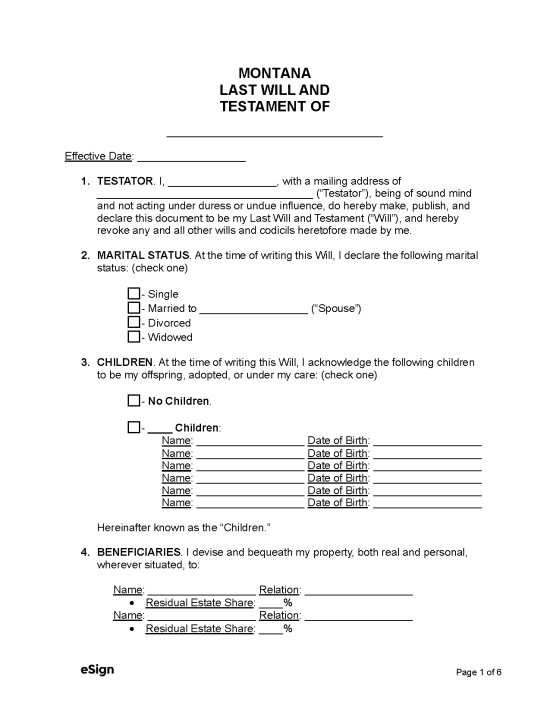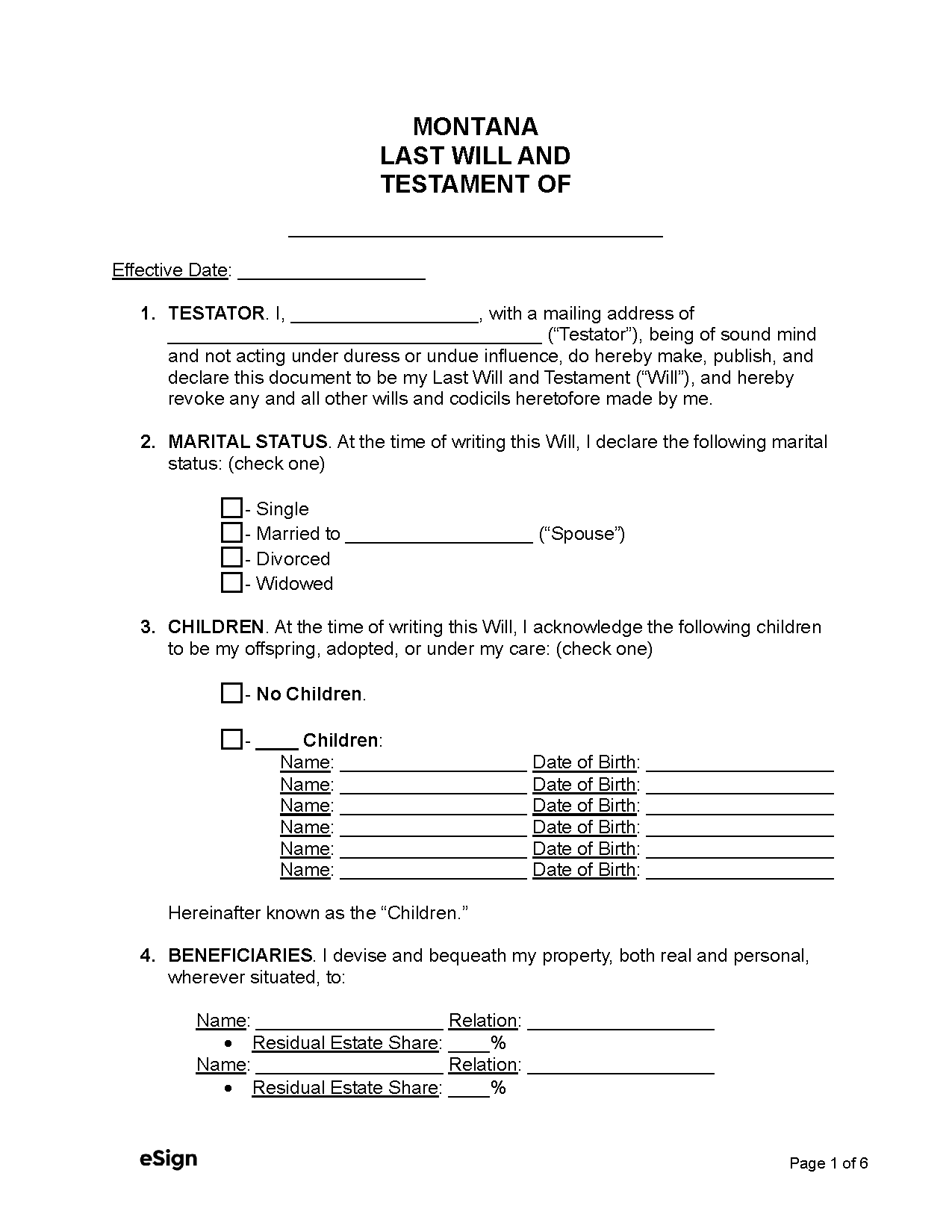A Montana last will and testament allows state residents to instruct how their estate should be distributed after death. It names the parties inheriting the estate’s assets and funds, and it lists the trusted individual assigned to handle administration. The document may also include instructions for the care of minor children and funeral arrangements.
One must be at least 18 years old and of sound mind to create a will.[1]
State Laws
Holographic Wills – A handwritten will is valid if signed and written by the testator, whether or not there are any witnesses.[2]
Revocation – A will is revoked upon its destruction or the creation of a new will.[3] Following a divorce or annulment of marriage, provisions applying to the testator’s former spouse become void.[4]
Signing Requirements – Wills must be signed by the testator and two witnesses. The signing of an interested witness does not alter the will or their inheritance.[5]
Probate Process in Montana (7 steps)
Probate can be initiated no sooner than 120 hours after the testator’s death, and no later than 3 years following their passing.[6],[7]
- File for Probate
- Accept Letters Testamentary
- Notify Parties
- Create Inventory and Settle Estate
- File Closing Statement
- Petition for Settlement (Optional)
- File Verified Application (Optional)
The following is meant to be a general overview of the probate process. It is recommended that executors/personal representatives consult with an attorney if they’re unsure of any step.
1. File for Probate
Rather than going through probate, an estate with a value of $50,000 or less can be collected and distributed with an Affidavit for Collection of Personal Property (or “small estate affidavit”).[8]
The personal representative has the priority to initiate probate, although it may be done by any interested party. While both formal and informal administration are options for probate, in most cases, the personal representative will file for informal administration (the process covered by this guide). To admit the will for informal probate, the following must be provided to the district court of the county where the decedent last resided[9]:
- Application for Informal Probate – This form requests that the court admit the will into informal probate.[10]
- Acknowledgment of Fiduciary Relationship – This document allows a personal representative to be appointed by the court and must be notarized or subscribed to under oath.[11]
- Last Will and Testament[12]
If the filings are approved, the court clerk will issue the personal representative a written statement of informal probate.[13]
2. Accept Letters Testamentary
The personal representative must file a Statement of Acceptance of Duties with the court clerk, which will allow them to receive the Letters Testamentary.[14] Once received, the personal representative is authorized to administer the estate. No bond is required in an informal administration unless demanded by an interested party.[15]
3. Notify Parties
Within 30 days of being appointed, the personal representative must mail a Notice of Appointment to all beneficiaries.[16] A Notice to Creditors must also be published in a newspaper once a week for three weeks to inform any creditors that claims against the decedent will be barred after four months. The personal representative is not required to mail any notice directly to creditors.[17] However, interested parties may demand that the personal representative provide them with a notice of any filing related to the estate.[18]
4. Create Inventory and Settle Estate
Once the notices are delivered and published, the personal representative must prepare an Inventory within nine months after their appointment, and send copies to interested parties upon their request.[19] The Inventory may also be filed with the court, though not mandatory.
The personal representative is also responsible for resolving debts or obligations, collecting the estate’s assets, and distributing them to the rightful beneficiaries.
5. File Closing Statement
Once the estate is fully administered, the period for creditors to submit claims has expired, and six months since the personal representative’s appointment has passed, a Closing Statement can be filed with the court.[20] The Closing Statement and an Accounting must be given to all beneficiaries, and a copy of the Closing Statement should be sent to any creditors with pending claims.[21]
If no proceedings are pending against the personal representative after one year from the Closing Statement’s filing, they are relieved of any further duties.
6. Petition for Settlement (Optional)
Instead of filing a Closing Statement, an estate may be closed by petitioning for an order of complete settlement (once the period for submitting claims has passed).[22] The personal representative must give a Notice of Hearing to interested parties at least 14 days before the hearing, and if any of their contact information is unknown, publish it in a newspaper for three weeks. Proof of delivering the notice must be filed before or at the hearing.[23]
During the proceeding, the personal representative may request that the court approve an Accounting or propose a distribution schedule. The court will then issue orders for the estate’s distribution and discharge the personal representative.
7. File Verified Statement (Optional)
If no actions against a personal representative are pending after their discharge, they may file a verified application with the court clerk. The clerk will issue a certificate demonstrating that the estate is fully administered and, if applicable, that any lien on property provided by the personal representative as a bond is discharged.[24]

